Telescope By Matthew Berge (late Ramsden) Owned By Horatio Stewart 95th Rifles
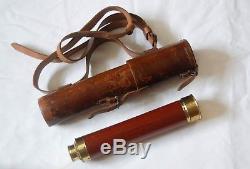

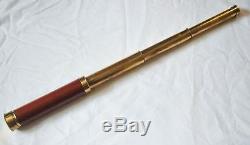
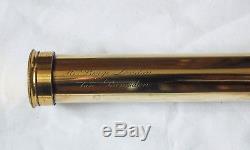
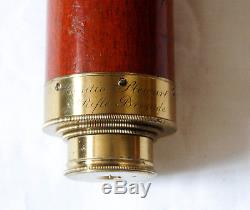
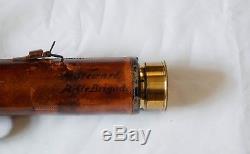
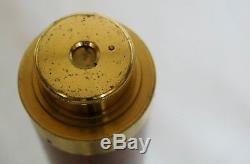

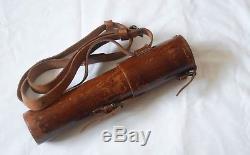

For sale, a George III three draw brass and mahogany telescope by Matthew Berge (Late Ramsden), London owned by Horatio Stewart of the Rifle Brigade, son of Sir William Stewart, founder of the regiment. This superior telescope comes complete with its original leather field carrying case (strap and buckle strap a later replacement) marked with pen and ink to Horatio Stewart. The telescope itself is further inscribed to Horatio Stewart, Rifle Brigade with the makers engraving to the first draw running left to right away from the eyepiece as is normal for telescopes from this period. It is marked to, M.
Of itself this piece is an item of superior quality coming from the workshops of Matthew Berge. His early instruments are signed Late Ramsden as he took over the business of the notable scientific instrument maker, Jesse Ramsden following his death in November of 1800. Berge had been Ramsdens foreman for many years prior to this, so was well placed to continue Ramsdens legacy. He was in fact an executor of his will. Berge continued to trade from Ramsdens workshop at 199 Piccadilly after paying off debts associated with repairs and building work.
The shop became 196 Piccadilly following the building of Regent Street and Piccadilly that was taking place at this point. He continued to produce quality scientific instrument until his death in 1819. Berge initially signed his instruments Late Ramsden following his securing of Ramsdens business so we can sensibly date this telescope to between 1801 & 1805 at the latest which does leave an interesting conundrum in respect of its initial ownership as Horatio Stewart was not born until at least 1805. It is likely that the telescope was originally owned by his father Sir William Stewart, founder of the Rifle Brigade and given to his son on his entering into service with the Brigade in April 1823 as a second lieutenant. Horatio Stewart is thought to have been named in remembrance of Admiral Horatio Nelson whom his father had a close relationship with prior to his demise at the Battle of Trafalgar. Given Horatios birth year and Nelsons year of death, this story holds particular weight. He was commissioned in 1823, gained his lieutenancy in October 1825 and his Captaincy in March of 1829 before finally exchanging to half pay in March of 1833. He died at Corsbie, at the family home in September 1835 and although the cause of his death remains a mystery, it is surmised that illness may have led him to revert to half pay, two years prior. The years of Horatios active service were somewhat of a fallow period for the Rifle Brigade following their heroic exploits during the Peninsula campaign and later at Waterloo. There are few records available for his exploits other than him leading a battalion to the Kent coast in order to tackle an increasing problem with bands of smugglers in the area. Their formidable presence must have dulled the smugglers enthusiasm as no record of any confrontation exists.His service must have been rather disappointing when his fathers exploits were considered. Sir William Stewart was a senior military figure having formed the Rifle Corps with Coote Manningham in 1800. Lieutenant Colonel Stewart was their first commanding officer and devised many of the drills and manoeuvres associated with the regiment.
After his posting to Nelsons fleet in 1801, he had the honour of delivering the news of the naval victory at the Battle of Copenhagen to London and was promoted to full Colonel shortly after. Nelson, continued to talk fondly of Stewart prior to his death and numerous letters can be found in the Stewart familys Cumloden papers.In 1802, the regiment was properly formed out of the experimental Rifle Corps 95. Foot and was commanded thereafter by Sir John Moore who died at the Battle of Corruna.
Stewart having been again promoted to Brigadier General left the 95. He took on command of the Second Division of the army in 1810.In 1811, Stewart led the Second Division at the Battle of Albuera where it was massacred by the French under General Soult although it held out long enough to gain support from the 4. Although he did not bear the blame for the episode, Wellington thereafter put Stewart under Lieutenant General Rowland Hills command for the rest of the campaign where he saw action at Salamanca, The Battle of the Pyrenees at the Maya Pass, Vittoria, Nive, Orthez and Toulouse where the cessation of war was finally completed. Stewart saw no further action after the Peninsula where he received numerous wounds. He received the Gold Cross with two clasps, the Portuguese Order of the Tower and Sword and theish Order of San Fernando for his services against Napoleon and later in 1815 was the recipient of the GCB (order of the Bath). Having been a member of parliament since the late eighteenth century, Stewart resigned from Parliament in 1818 and transferred back to the Colonelcy of the First Battalion of the Rifle Brigade.
Given the date of the manufacture of the telescope (1805 at the latest), it is therefore likely that the telescope was originally owned by Sir William Stewart during his active service in the Peninsula and was handed down to his son and was a gift on his entering into service within Stewarts beloved regiment. There are two documented telescopes by Matthew Berge that now form part of the National Army Museum collection and are known to have formed part of Wellingtons service accoutrements during both the Peninsula campaign and also at Waterloo so although the attribution cannot yet be proven, it is clear that the leading officers of the British army were frequenting Berges workshops and were of an unmatched quality during the period of the Napoleonic Wars. Horatio could not have bought this telescope at the time of its manufacture because he was not yet born and it is unlikely (given his position in society) that he would have bought a second hand telescope and engraved his own details upon it. Period items from the early part of the Rifle Brigades history are now almost solely held in museum collections so this is a scarce opportunity to own an early scientific instrument which was oened by a family who were instrumental in the formation of the much beloved and historic regiment.
Jason Clarke Antiques are happy to discuss carriage, condition or for any other queries, alternatively, you can also message me and I will endeavour to come back to you as soon as possible. I have a number of beautiful antiques for sale, so please feel free to browse my other items. The item "TELESCOPE BY MATTHEW BERGE (LATE RAMSDEN) OWNED BY HORATIO STEWART 95TH RIFLES" is in sale since Friday, August 25, 2017. This item is in the category "Antiques\Science/Medicine\Scientific Instruments". The seller is "jason750_1" and is located in newbury, Berkshire. This item can be shipped to United Kingdom.- Period: 1800 to 1900
- Material: Brass
- Type: Telescope

